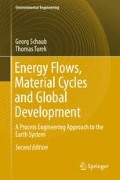Abstract
For human societies, there are various limiting factors for development, such as availability of food, raw materials for producing goods, capital for investment, environmental effects, and/or international conflicts. In the context of this book, this chapter introduces five factors representing the supply of energy and raw materials, as well as environmental effects on regional and global scales. It remains an open question, which of these factors will become the most determining and when.
Access this chapter
Tax calculation will be finalised at checkout
Purchases are for personal use only
References
Barney GO (1981) The Global 2000 Report to the President. Blue Angels, Charlottesville
BGR Bundesanstalt für Geowissenschaften und Rohstoffe (2014) Energiestudie 2014 – Reserven, Ressourcen und Verfügbarkeit von Energierohstoffen. BGR, Hannover, http://www.bgr.de. Cited 20 Mar 2015
BP (2014) BP Statistical Review of the World. http://www.bp.com. Cited 20 Mar 2015
Daten zur Umwelt (1997) Umweltbundesamt, Erich Schmidt Verlag, Berlin
FAO Food and Agricultural Organization (2003) http://www.faostat.fao.org
FAO Food and Agricultural Organization (2015) http://www.faostat3.fao.org. Cited 20 Apr 2015
Fischer Weltalmanach (2004) Der Fischer Weltalmanach 2005: Zahlen, Daten, Fakten. Fischer Taschenbuch Verlag, Frankfurt am Main
Fischer Weltalmanach (2014) Der Fischer Weltalmanach 2014: Zahlen, Daten, Fakten. Fischer Taschenbuch Verlag, Frankfurt am Main
Gerling JP (2005) Erdöl-Reserven, Ressourcen und Reichweiten: eine Situationsbeschreibung aus Sicht der BGR. Bundesanstalt für Geowissenschaften und Rohstoffe BGR, Hannover, http://www.bgr.de. Cited Nov 2005
Graßl H Kokott J, Kulessa M, Luther J, Nuscheler F, Sauerborn R, Schellnhuber HJ, Schubert R, Schulze ED (2003) Über Kyoto hinaus denken – Klimaschutzstrategien für das 21. Jahrhundert. Special Report, Wissenschaftlicher Beirat der Bundesregierung Globale Umweltveränderungen WBGU, http://www.wbgu.de. Cited Oct 2009
Heintz A, Reinhardt GA (1993) Chemie und Umwelt. 3rd edn. Vieweg, Braunschweig
Hiller K (1997) Future World supplies: possibilities and constraints. Erdoel Erdgas Kohle 113:349–352
Hiller K, Kehrer P (2000) Erfahrungskurven bei der Suche nach und Förderung von Erdöl. Erdoel, Erdgas, Kohle 116:427–430
Holm Nielsen JB, Oleskowicz-Popiel P, Al Seadi T (2007) Energy Crop Potential for Bioenergy in EU-27. Paper presented at 15th European Biomass Conference and Exhibition fom Research to Market Development, Berlin May 2007
Hubbert MK (1969) Ressources and Man. In: Ressources and Man: A Study and Recommendations by the Committee on Ressources and Man. W.H. Freeman, San Francisco
IPCC Intergovernmental Panel on Climate Change (2007a) Climate Change 2007 – The Physical Science Basis. Contribution of Working Group I to the Fourth Assessment Report of the IPCC. Technical Summary. Cambridge University Press, Cambridge
IPCC Intergovernmental Panel on Climate Change (2007b) Climate Change 2007 – The Physical Science Basis. Contribution of Working Group I to the Fourth Assessment Report of the IPCC. Chapter 10 – Global Climate Projections. Cambridge University Press, Cambridge
IPCC Intergovernmental Panel on Climate Change (2007c) Climate Change 2007 – Impacts, Adaptation and Vulverability. Contribution of Working Group II to the Fourth Assessment Report of the IPCC. Chapter 4 – Ecosystems, Their Properties, Goods and Services. Cambridge University Press, Cambridge
IPCC Intergovernmental Panel on Climate Change (2014) Climate Change 2014 – Mitigation of Climate Change. Contribution of Working Group III to the Fifth Assessment Report of the IPCC. Cited 16 Mar 2015
Jess A, Kaiser P, Kern C, Unde RB, von Olshausen C (2012) Considerations concerning the Energy Demand and Energy Mix for Global Welfare and Stable Ecosystems. Chem Ing Tech 83:1777–1791
Kauwenbergh S (2010) World Phosphate Rock Reserves and Resources – International Fertilizer Development Institute Alabama (USA). http://pdf.usaid.gov/pdf_docs/PNADW835.pdf. Cited 18 Aug 2013
Killiches F, Gebauer HP, Franken G, Röhling S, Schulz P, Müller HW (2013) Phosphat – Mine-ralischer Rohstoff und unverzichtbarer Nährstoff für die Ernährungssicherheit weltweit. Report Bundesanstalt für Geowissenschaften und Rohstoffe BGR. http://bgr.bund.de/DE/Themen/Zusammenarbeit/TechnZusammenarbeit/Politikberatung_SV_MER. Cited Jun 2015
Lossin A (2012) Copper. In: Ullmann’s Encyclopedia of Technical Chemistry. Electronic Release, 7th edn., Wiley-VCH, Weinheim
McKay DJC (2008) Sustainable Energy – Without the Hot Air. UIT Cambridge, Cambridge 2008
McNeill JR (2000) Something New under the Sky. WW Norton & Company, New York
Meadows D, Meadows D, Zahn E, Milling P (1972) The Limits of Growth. Universe Books, New York
Miller RG, Sorrell SR (2014) The Future of Oil Supply. Phil Trans R Soc A 372:20130179
Mocker M, Aigner J, Kroop S, Lohmeyer R, Franke M (2015) Technologierohstoffe für erneuerbare Energien – Verfügbarkeit und ökologische Aspekte. Chem Ing Tech 87:439–448
MWV Mineralölwirtschaftsverband (2015) Jahresbericht 2015–Mineralöl-Zahlen 2014, http://www.mwv.de. Cited 10 Dec 2015
Sandrea R (2004) Hubbert Revisited – 1: Imbalances among oil demand, reserves, alternatives define energy dilemma today. Oil Gas J 102:34–37
Schaub G, Vetter A (2008) Biofuels for Automobiles: An Overview. Chem Eng Technol 31:721–729
Scholz R, Wellmer FW (2013) Approaching a dynamic view on the availability of mineral resources: What we may learn from the case phosphorus? Glob Environ Chang 23:11–27
Speirs J, Contestabile M, Houari Y, Gross R (2014) The future of lithium availability for electric vehicle batteries. Renew Sust Energ Rev 35:183–193
Sverdrup HU, Ragnarsdottir KV (2014) Natural Resources in a Planetary Perspective. Geochem Persp 3:129–341
Wietelmann U, Steinbild M (2014) Lithium and Lithium Compounds. In: Ullmann’s Encyclopedia of Technical Chemistry. Electronic Release, 7th edn., Wiley-VCH, Weinheim
U.S. Geological Survey (2015) Mineral commodity summaries 2015: U.S. Geological Survey, http://dx.doi.org/10.3133/70140094
World Petroleum Council (2012) Unconventional Gas, http://www.world-petroleum.org. Cited 20 Apr 2015
Author information
Authors and Affiliations
Corresponding author
Rights and permissions
Copyright information
© 2016 Springer International Publishing Switzerland
About this chapter
Cite this chapter
Schaub, G., Turek, T. (2016). Limits for Anthropogenic Material and Energy Flows. In: Energy Flows, Material Cycles and Global Development. Environmental Science and Engineering(). Springer, Cham. https://doi.org/10.1007/978-3-319-29495-7_6
Download citation
DOI: https://doi.org/10.1007/978-3-319-29495-7_6
Published:
Publisher Name: Springer, Cham
Print ISBN: 978-3-319-29493-3
Online ISBN: 978-3-319-29495-7
eBook Packages: Earth and Environmental ScienceEarth and Environmental Science (R0)

